Choose from the following Questions:
Motor Repair & Shipping Questions | General Motor Questions | Bearing Questions | Bosch Motor Questions | Brose Motor Questions | Impulse Motor Questions | Yamaha Motor Questions
Motor Repair & Shipping Questions
How much does it cost to repair my motor?
As a very rough guide for most ebike motors, the lowest price is £60 to £80.00 and worst-case scenario would normally be £250.00 to £350.00. (It is not common, but if internal parts require changing, this cost may be exceeded. Again, you will be informed of this before any work is carried out).
What is your current turnaround time?
This page is regularly updated if this time changes. We are currently operating on a 10 to 12 working day turnaround from the time your motor arrives with us.
Who should I use to send my motor with?
The courier you pick to send your motor to us is entirely your decision. Most seem to do a very reasonable job these days. You may want to save yourself some time and money by booking through companies such as https://www.parcelmonkey.co.uk or https://www.parcel2go.com
What is involved with a full overhaul?
Your motor will first be tested, then all internal drive train parts removed for ultrasonic cleaning and inspection.
All drive train bearings will be removed and replaced with original or better. New grease will then be applied to all relevant surfaces and extra specialist greases maybe used to help protect from wear or water ingress. New seals, O-rings and circlips fitted. The motor is then reassembled in our clean, custom built workshop. (In the event that a part has failed or worn, you will be contacted before we go ahead and fit a new part).
What is involved in a service/repair?
Your motor is stripped and inspected, then we contact you with a report and price before going ahead with any work. Usually, just the parts or bearings that have failed will be replaced. Often with certain makes of motor a full overhaul is normally required anyway.
General Motor Questions
My motor is creaking, is it the bearings?
Bearings do not usually creak. When people bring their bikes to us with these noises, here are all the reasons we have found for motors, of all types, creaking or cracking, so far: Motor bolts loose, (causes motor to creak against the frame), chainring to spider bolts loose, crank arms loose, pedal creak, seat post creaking, rear suspension linkages creaking, front sprocket loose (normally wrong type of sprocket fitted to Bosch or worn spider carriers for Yamaha). Loose spokes in the rear wheel or rear wheel spindle creaking. (when we say loose, this does not mean undone, but not tight enough to stop creaking)
Is my motor waterproof?
The answer is, probably not. Currently, it would be commercial suicide for ebike motor manufacturers to properly seal a motor because this would lead to added friction and lower battery range. This does not look good on comparison charts when people are deciding which bike to buy. Most road bikes don’t require seals and mountain bikes make up about 10% of the market. Get the picture? Most current bike motors rely on the bearings’ dust seals rather than any dedicated water seal. This situation is good enough for most road bikes but bikes used off road will struggle.
How can I protect my motor from water ingress?
There are aftermarket products for some motors, but not all. There are also some simple steps that can help: Wash your bike upright, not on its side. Store your bike upright, in a dry area. If you transport your bike behind a vehicle, ensure the motor is covered if the roads are wet. Do not direct a water hose at the motor, especially the crankshaft area. Never pressure wash your bike (it’s not a motorbike – none of the motor bearings, wheel bearings or frame bearings have protective seals in front of them). Do not ford any water deeper than the bottom of the motor.
If water gets into my motor, will it dry out?
Yamaha do have a small breathable membrane that allows the motor to dry out over a very long period of time. If the water is more than a drip, the motor will be in trouble. Most other motors do not have this small membrane and once water is inside, it cannot escape. (Motors are definitely not designed to have moisture of any kind inside them).
My crank is sometimes seized when I push my bike out the garage?
This is because water has entered a bearing during washing or your last ride. Water will rust the balls of the bearing to the bearing race. This generally signifies the beginning of the end for the bearing.
Is it ok to put some oil on the bearings or down the crankshaft?
No! If you feel you have to put oil on bearings there is already something wrong that requires attention. Also, these motors are not designed to have oil inside them. It can cause issues with clutch bearings, circuit boards, coatings and lubricants. Above all it makes a horrendous mess that we normally have to clean out! Even just a couple of drops every now and again will build up over time.
Does riding in turbo/power mode cause extra wear or damage to the motor?
Turbo or power mode is adding slightly more power through the drive train and therefore will possibly wear the motor out maybe a few miles faster than some of the lower power levels, but to be honest, we have not witnessed any difference in any motor used extensively on full power to any other motor used predominantly in low power. We have not yet seen a motor worn out or failed because it was used in its higher power levels.
Do tuning dongles or chips cause any damage?
We have never seen any damage caused to a motor by the use of a de-restricting device.
What can cause damage or wear to a motor apart from water and dust?
We see slightly higher wear rates in motors used with low cadence (rpm) in high gears, so the motor is spinning relatively slow but trying to add full power. Pedalling at higher cadence is definitely better and more efficient for the motor. Damage can be caused by pedal strikes and crashing, but that’s about it! Motors are generally very resilient if looked after.
When should I get my motor serviced?
Most ebike motors are not serviceable items and if kept dry will last for thousands of miles. Yamaha and Impulse motors are an exception to this rule as they have a particular grease that wears away or dries out, this can cause excessive drag and wear. Yamaha and Impulse do not give a recommended mileage for this but from our experience we would service a Yamaha used off road after 1,500 to 2,000 miles and if used on road 3,000 to 4,000. We would recommend servicing an Impulse motor 1,500 miles at the latest.
Can I get more power from my motor?
Currently, it is not possible to achieve this in a simple way.
Can I change my motor for a newer model?
In some cases this would be possible, but not as easily as it sounds. Motors can differ greatly from one model to the next; size, crank type, mounting bolt size and position, wiring plug type and position, etc. These can all change, along with compatibility with older batteries and controllers.
If you get over these issues, then aligning the chain, crank height, crank position fore and aft etc. Then you have chainring size, gearing, etc…
Normally, it’s currently cheaper and easier to buy a new bike.
Bearing Questions
Can I re-grease the bearings?
The bearings in all ebike motors are already greased and should be good for the life of the motor. If a bearing has been damaged by water or dirt ingress, it will be permanently damaged and no amount of special grease will help. You will just make the inevitable quieter.
Why are ebike bearings so bad?
Ebike bearings are often high quality, over engineered bearings. Way bigger and stronger than they need to be. The bearings are not to blame, it’s normally more to do with the environment that the bearings have to deal with.
What if I just keep riding, noisy bearings last for ages don’t they?
Not with an ebike motor ridden in harsh conditions or washed regularly they don’t. Lets look at a crankshaft bearing for example: As the bearing wears, the ball bearings within it become smaller, this allows movement of the bearing and can usually be felt as play in the crankshaft. This “play” lifts the bearing seals from their seats and this allows water and dirt to enter the bearing, speeding up the total failure. If you can hear the bearings whilst riding, it is already too late!
What type/quality of bearings do you use?
We always try to use original or better bearings. There are some cases where a manufacturer may favour a low friction bearing over a well sealed bearing. If we have seen a particular bearing is failing frequently in the field then we will change it for a better sealed bearing for example.
Bosch Motor Questions
All Bosch motors are very different internally. When diagnosing or quoting for repair, it’s important for us to know exactly which motor you have. It’s very common to believe you have a Gen 3 motor when you actually have a Gen 2. Hopefully this page will help you correctly identify your motor.
Which generation is my Bosch motor?
Generation 1
Gen 1 Bosch “Classic” Line 50Nm (2011 – 2014) Mostly fitted to road bikes, but used in a few early EMTB’s such as Moustache and Haibike.
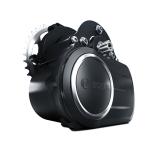
Generation 2
- Gen 2 Active Line 48Nm 2014 – 2018. Mostly fitted to road bikes. Early motors are silver, later ones were black
- Gen 2 Performance Line 50Nm for hub gear, 63Nm for derailleur 2014 – 2019. Fitted to road bikes and some early EMTB’s. Early motors were silver, later ones were black.
- Gen 2 Performance Line CX 75Nm 2017 – 2019. Mostly fitted to Bosch powered EMTB’s and a few road bikes. Because this motor was fitted until 2019 and followed directly by the Bosch Gen 4 motor, it is often confused for the Gen 3 road bike motor.
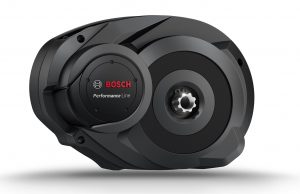
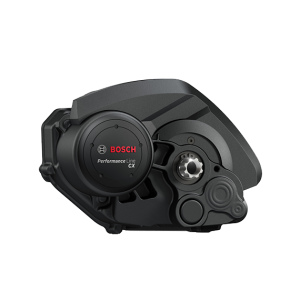
Generation 3
- Gen 3 Active Line 40Nm 2018 – current. Road bike motor for flat city riding and long battery life.
- Gen 3 Active Line Plus 50Nm 2018 – current. Road bike motor for urban riding with small hills. Same motor, a little more power, but still better battery consumption.
- Gen 3 Performance Line (not available in CX) 65Nm 2018 – current. Road bike motor for touring i.e. longer, higher hills. Also fitted to a few gravel bikes. (NOT FITTED TO MOUNTAIN BIKES)
NOTE The large chain wheel, not used on the Gen 2.
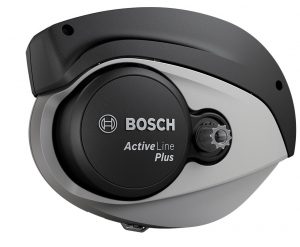
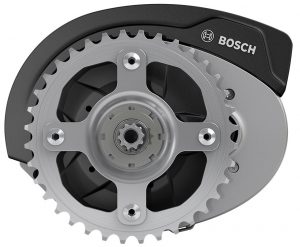
Generation 4
- Gen 4 Performance Line CX 75Nm. Mountain bike motor. Later upgraded to 85Nm 2020 – current.
- Gen 4 Speed Line and Cargo Line motors are also available but essentially, all the motors are designed specifically around a certain job and battery consumption.
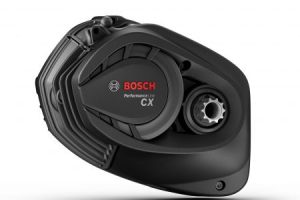
Does my Bosch motor require regular service?
Bosch motors are not designed to be serviced and should only be fixed if they start to fail. The motors are sealed for life and if kept dry will do in excess of 50,000 miles (80,000km) without problem.
My Bosch motor sounds a bit rough, should I just keep riding it until it stops?
No! If you can hear your motor is noisy while riding, it’s already too late! The bearings have failed, the balls within the bearing will be wearing rapidly; as they wear they get smaller, this causes the seals of the bearing to be lifted from their seat’s allowing water or dirt straight into the motor! All ebike motors fail like this when the bearings are in distress, and it’s a cascading effect. Don’t ignore any change in noise level from your motor, there are limits to what can be repaired.
Why do the bearings fail, are they bad quality?
The bearings fitted to most Bosh motors are extremely good quality and well sealed, but although a bearing is classed as “sealed” it is not waterproof! They are at best water and dust resistant. This is the same for 99% of the ebike motors on the market.
Why don’t they seal ebike motors against water and dirt?
It would be very easy to seal a motor during design stage, but seals add drag and drag equals battery consumption. It would be commercial suicide for a manufacturer to release a motor that achieved even 1 mile less battery range than their competitor!
My motor is creaking, are the bearings failing?
Bearings tend to rumble, grind, crunch intermittently or seize. They don’t generally creak. Creaking is usually caused by one of the following:
- Loose motor bolts. This causes the aluminium motor body to creak against the aluminium frame.
- Seat post creaking in the frame (most noises travel down the frame and emanate from the motor area).
- Crank arm loose
- If spider and chainring fitted, (Gen 3 and 4) check chainring bolts
- Pedal creaking
- If fitted, suspension linkage creaking
- Rear wheel axle loose
Can I get any extra seals for my Bosch Gen 4 motor?
There is now an upgrade service to solve one of the main causes of water ingress into this motor, you can find out more here: Upgrade Although there are already some pretty good seals fitted to this motors crankshaft bearing from new. They do need removing and re-greasing from time to time and this will depend on your riding terrain, cleaning habits, weather conditions, etc.
Will fitting a tuning dongle damage or wear my Bosch motor?
We have never seen any damage caused to a motor by the use of a de-restricting device.
What can cause damage or wear to my motor apart from water and dust?
We see slightly higher wear rates in motors used with low cadence (rpm) in high gears, so the motor is spinning relatively slow but trying to add full power. Pedalling at higher cadence is definitely better and more efficient for the motor. Damage can be caused by pedal strikes and crashing, but that’s about it! Motors are generally very resilient if looked after.
When should I get my motor serviced?
Bosch motors are not serviceable items and if kept dry will last for thousands of miles.
Can I get more power from my motor?
Currently, no.
Can I change my motor for a newer model?
In some cases this would be possible, but not as easily as it sounds. Motors can differ greatly from one model to the next; size, crank type, mounting bolt size and position, wiring plug type and position etc. These can all change, along with compatibility with older batteries and controllers.
If you get over these issues, then aligning the chain, crank height, crank position fore and aft etc. Then you have chainring size, gearing etc.
Normally, it’s currently cheaper and easier to buy a new bike.
Brose Motor Questions
Does my motor need regular service?
Brose motor should have its drive belt changed after 9,300 miles (15,000km). The rest of the motor is not designed to be serviced and should only fixed if it starts to fail.
Motor works on walk assist but will not work when I pedal?
This is usually caused by failure of the torque sensor and should be sent to us for torque sensor replacement.
My crank is stiff to turn backwards
This is normally the first sign that your motor crankshaft needle roller bearing is failing due to rust or a build-up of dust or grit.
My motor makes cracking, popping or screeching sounds
A fairly sure sign that one of the two motor clutch bearings are failing. Definitely worth getting this investigated as it will result in complete loss of drive.
My motor runs on when I stop pedalling
This can be one of two reasons:
- The crankshaft needle roller bearing is badly seized, breaking up or contaminated. This causes the crankshaft and sprocket carrier (torque sensor) to become one or very stiff to turn independently of each other.
- The clutch bearing is starting to fail and the ‘sprags’ (small feet that lock the bearing) are beginning to jam or stick. Both these scenarios allow the motor to continue to add power because it can only see that the crankshaft is still turning. This may happen right up to the cutoff speed.
Impulse Motor Questions
Does my motor need regular service?
No, these motors are not designed for regular servicing. However, one of the main causes of failure for this motor is the grease used for lubricating the steel gears and freewheel pawls. There are several major issues caused by this and the sooner this grease is removed and changed for a lighter grease the better.
Can you fix the Kalkhof clack?
Yes, we have identified the issue and it is fixable.
My motor seems to be getting louder?
This is quite usual for this motor and it should be addressed as soon as possible. The reason for this, and most failures on this motor, is the grease (one thing Impulse never changed!) There are two metal gears in this motor, one gear is small and hard, the other gear is large and very soft. The hard gear shaves metal from the soft gear, these metal filings stick to the grease between the gear teeth and start to build up and put pressure on the support bearings. This pressure slowly builds as more metal debris is packed between the teeth, until the smaller of the bearings collapses. This does not usually take too long to happen.
My pedals slip and catch sometimes?
This is usually caused by the grease getting old and sticking the freewheel pawls down so that they cannot engage properly with the ratchet. If left, this will destroy the freewheel mechanism and steel drive gear ratchet. This is a lot of damage and should be addressed as soon as possible.
Yamaha Motor Questions
My Yamaha motor seems to be getting nosier or stiffer over time?
Yamaha tend to use a grease that dries out or disperses over time. After approx 1,500 miles they could normally do with a cleanout and refresh. This quietens them down quite a bit. Obviously if bearings are beginning to fail, this will also increase noise.
My Yamaha motor seems noisy compared to other Yamaha motors?
The later Yamaha motors seem a little worse for this and we have found poor or damaged internal bearings on some brand new motors. However, usually it is caused by poor gear meshing, this can sometimes be rectified by swapping gears around but this is not really a practical fix.
My Yamaha motor is showing fault code 34 or 64, or any torque sensor error.
This is usually a fault of the printed circuit board (PCB) and is usually a good indication that the PCB has failed. Fortunately we now stock Yamaha PCB’s
Is Giant SyncDrive a Yamaha Motor?
Giant SyncDrive motors are basically a standard Yamaha motor with Giant software, we can fix any mechanical issue with Giant Yamaha motors as we can Yamaha. We cannot supply PCB boards for Giant SyncDrive motors.
I have a Giant SyncDrive and the motor has failed, can I fit a standard Yamaha motor?
No. Giant have locked down this possibility by insisting that the Giant battery and Giant controller must see or talk to a Giant motor. Without one of these parts in the loop, nothing works.
I can feel play in my Yamaha crankshaft
You should feel 1mm of lateral play (i.e. push and pull the crankshaft). This is not caused by axial play of the bearing. You should not feel any radial play (i.e. lift and lower the crankshaft).
How do I tell which Yamaha model I have?
If your bike was manufactured before 2020 take a look at how the pedal crank arms connect to the motor. This will be an ISIS drive or a square drive. If your motor has an ISIS drive it should be a PW-X or PW-X2.
If your motor has a square drive it should be a PW or PW-SE (Later motors are PW-ST, PW-TE or PW-CE).
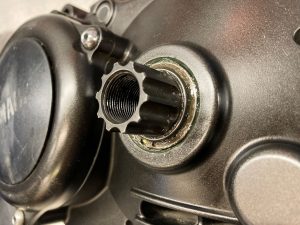
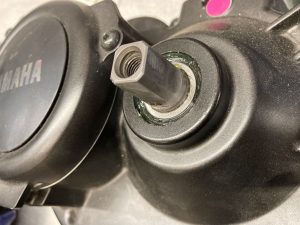
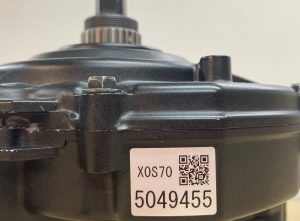
We may need you to more accurately identify your motor and this can be done by letting us have the numbers found on the silver sticker that you should find on the bottom of your motor.
My Motor is creaking on each pedal stroke
My motor is slipping or jumping
This is a very common symptom of worn chain or sprockets, not usually the motor (except for example below). This issue can usually follow changing the chain without changing the sprockets or vice versa. On an ebike you are putting 3 or 4 hundred percent more power through the drive train and this will show up issues that would not normally present themselves on a normal pushbike.
My pedals slip and catch sometimes?
This is usually caused by the grease getting old and sticking the freewheel pawls down so that they cannot engage properly with the ratchet. If left, this will destroy the freewheel mechanism and steel drive gear ratchet. This is a lot of damage and should be addressed as soon as possible.
